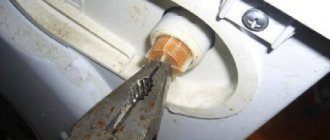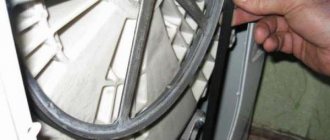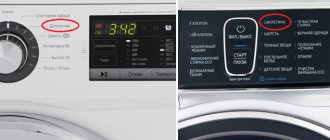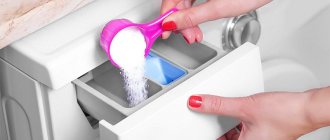Think about how much the washing machine drum vibrates? In spin mode, it performs from 700 to 1800 rpm. Important parts help the machine withstand such a load - two shock absorbers under the tank. In this article we will tell you how shock absorbers for a washing machine are designed, why they break and how to replace them with your own hands.
Relevant for most brands of washing machines: AEG / AEG, Asko / Asko, Aurica / Aurika, Beko / Beko, Bosch Classixx, Logixx, Maxx Comfort / Bosch Classics, Logix, Max Comfort (or Maxx); Candy / Kandy, Electrolux EW, EWF, EWS / Electrolux; Gorenje / Gorenje, Haier / Hayer, Hansa / Hansa, Hotpoint Ariston Margherita / Hotpoint Ariston Margherita, Indesit / Indesit, LG / LG / LZh, Miele / Mile, ReNova / Renova, Samsung Diamond / Samsung Diamond, Siemens Siwamat / Siemens Sivamat; Vestel / Vestel, Whirlpool / Whirlpool, Zanussi / Zanussi; Alenka, Assol, Atlant, Vyatka, Riga, Siberia, Smena, Eureka and others, including direct drive equipment.
Dismantling and installing the part
How to remove shock absorbers? In fact, there is nothing complicated about it. To remove the dampers, you need to remove the “top” and the rear panel of the case, which is very simple to do. On some Bosch models, you will have to “unhook” the front wall to gain access to the parts. Then the algorithm of actions will be as follows:
- remove the lid from above. To do this, unscrew the two bolts, lightly press on it and slide it back;
- remove the detergent dispenser;
- remove the lower decorative panel hiding the garbage filter;
- Unscrew the bolts securing the control panel. Carefully place it on top of the automatic machine so as not to break the wires connecting the part to the control module;
- open the hatch door, remove the metal clamp holding the cuff, insert the elastic into the drum;
- Unscrew all the screws securing the front wall of the machine;
- disconnect the hatch locking device from the body;
- remove the front panel;
- find the dampers. They are located below, under the washing tank;
- unscrew the bolt securing the shock absorber or damper to the body (it may be necessary to remove the latch);
- remove the shock-absorbing elements.
Then you need to examine the disconnected shock absorbers and see what exactly is broken. You may not need to purchase new spare parts; repairing the part will suffice. If not, all that remains is to purchase and install serviceable components by performing the described steps in reverse order.
Replacement procedure
Let's find out how to replace the shock absorbers of a washing machine with your own hands. You will need a screwdriver and a set of wrenches. First you need to get easy access to them. On some models, simply remove the back cover. If your shock absorbers are located in the front, then you will need to complete the following points:
- Remove the bolts and then remove the top cover of the washing machine.
- Remove the powder receptacle and the bottom plastic panel. Be careful! Do not damage the wires.
- Remove the cuffs and release the metal clamps.
- Unscrew all the bolts by removing the front part of the machine.
- Remove the wires or the door lock completely.
- Dismantle the façade of the building.
- At the bottom of the machine on the sides there are shock absorbers. Unscrew the bolt that secures the element to the body or remove the latch (depending on the specific model).
- Disconnect the shock absorber from the tank in the same way as described above.
- Install the new part and then reassemble in reverse order.
In the worst cases, it will be structurally impossible to disconnect the shock absorber from the tank. Then you just have to completely remove the tank. This is a rather complicated procedure. If you do not want to cause additional damage, contact a professional. When purchasing new parts, it is recommended to pay attention to the article numbers to be sure that the product is compatible with the model of your machine.
Source
Why repairing shock absorbers is a questionable decision
Shock absorbers (dampers) dampen vibrations of the washing machine drum during spinning and are a structure consisting of a housing - cylinder, a piston rod and a gasket between them. The piston moves inside the cylinder with a force of 80 to 120 Newton. Resistance is provided by a gasket and a special lubricant that increases friction.
As the machine is used, the gasket between the piston and cylinder wears out, the lubricant leaks out and dries out. As a result, the resistance decreases, the rod begins to move freely in the cylinder, and the shock absorber ceases to perform its functions. Gaskets are not sold separately, so it is impossible to repair the shock absorber, and you have to completely replace it.
Diagnosis of typical faults
Shock-absorbing devices of washing machines belong to the mechanical part of household equipment. Their repair and replacement do not require fundamental knowledge in the field of electrical or even mechanics. This means that even the intervention of an amateur will not be able to cause serious damage.
Please note that unique technical documentation is issued for each model of washing unit. Service techniques are usually authorized and devices are patented. However, there are methods for repairing shock-absorbing devices that are common to almost all types of washing machines, the specifics of which are worth understanding.
The appearance of typical damage to shock absorbers or dampers will be signaled by a specific noise that occurs during operation of the machine, or too much knocking inside its body.
If alarming sounds are detected, their condition should be examined, and for this you need to provide yourself with access to the devices being tested. Depending on the model, for the examination you will need to remove either the top panel, the side panel, or the back panel.
Methods for diagnosing shock absorbers for washing equipment depend on the type of load:
- From the front. If, when applying force to the tank from above, folds form on the sealing collar of the loading hatch, the shock absorbers must be replaced. By the way, you can also notice a couple of folds while the machine is operating with worn-out accessories.
- From vertical. If, when applying force to the tank from above, no resistance is felt, and the tank, after interrupting the pressure, continues to swing like a pendulum, it needs to be repaired.
When carrying out diagnostics with top loading, you must definitely pay attention to how much the tank sags when pressed, if the indicated defect occurs. It would be nice to track the fact of sagging and its conditional value with a full tank load
It is imperative to check whether there is at least some reserve for the reciprocating movement of the tank of the washing machine being examined. If it sags so that there is simply no room left for it to move during vibration, then a loud knock will occur during washing or spinning. And this is a sure sign of damage to the tank in the near future, and simply imbalance.
In normal technical condition, front-loading washing machines should not have cuff folds at all, regardless of the function being performed. Note that the formation of a single fold on this rubber seal indicates that only one of the shock absorbers is damaged.
If the folds on the cuff of the washer do not indicate damage to the shock absorbers, it means that it is worn out or deformed from the use of substances undesirable for its structure. In this case, the seal should be replaced.
In normally functioning units with a top load, if the shock-absorbing devices are not damaged, after applying force to the tank from above and abruptly interrupting the load, i.e. retracting the hand, the tank should smoothly return to its original place without excessive swinging and vibration.
Causes and symptoms of malfunction
Malfunctions in the operation of washing machine dampers occur for the following reasons:
- Wear of mating elements (o-rings);
- Long-term loads and vibrations;
- Drying of the lubricant inside the cylinder and violation of operating rules. Branded shock absorbers in Samsung, LG, Siemens, AEG, or Ariston washing machines usually last 5-7 years without any visible disturbances in their operation.
With constant overload of the washing drum, especially in spin modes, the service life of the damping elements decreases. You can determine that the shock absorber is faulty based on several signs:
- strong vibration of the washing machine body, especially at high speeds; characteristic knocking sound when washing;
- The engine drive belt constantly weakens and falls off;
There are several ways to check dampers for working condition:
Remove the top cover of the washing machine. After removing the cover, press firmly on the washing tank, it should smoothly return to its place, but if the tank returns jerkily, this means that the devices are not working properly and require replacement.
The second, more reliable way to check is to completely remove the shock absorbers from their seats.
Replacing suspension springs
Another shock-absorbing element is steel springs, with the help of which the drum is suspended inside the housing. They are located in the upper part of the machine body. These are quite reliable elements, the replacement of which is required extremely rarely. Sometimes the spring hooks pop out of the eye holes due to vibration; to easily install them in place, just lift the drum.
Not only the quiet operation of the washing machine, but also protection from vibration loads of other elements depends on the reliable operation of the dampers. If shock absorbers break down, it is best to replace them in a service center with a warranty.
Source
How to remove and check shock absorbers from a washing machine
All damping elements are protected by the body and lining; in order to get to the damper mounts for different models of washing machines, different disassembly approaches are required.
When replacing dampers on a washing machine, there is no need to completely disassemble it. For example, to provide access to shock absorbers on Bosch washing machines, simply remove the front cover. In these models, the dampers have a classic single-bolt mount, located at the bottom of the unit. The upper part of the attachment to the tank is held on by latches that are part of it.
In order to remove the shock absorber from the tank, the connection is drilled with a long drill with a diameter of 13 mm, then you need to remove the part through the front of the machine.
On some LG models, you do not need to remove any covers to remove the damper. To do this, just put the unit on its side, having previously disconnected it from the power supply, water supply and sewerage. The shock absorber is secured on both sides with plastic pins with locking latches. By pressing the latch, you can easily remove your finger from the hole, freeing it from the fastening. If the finger is very difficult to remove, you can use a special tool such as a car VD shk.
In Samsung washing machines, bolts of size M8 or M10 are most often used to secure dampers. They are unscrewed using spanners or socket heads, 12-13 mm in size. Bolt-on mounting is used on models from Miele, AEG and many other manufacturers. In Wirhpool models, the shock absorbers on both sides are fastened with special latches; by pressing them, you can freely remove the damping elements.
If the rod extends freely and there is no lubrication, and traces of rust are visible inside, we can talk about wear and tear and unsuitability of the shock-absorbing devices.
Symptoms of failure
The most common symptom of shock absorber failure is vibration, which cannot be eliminated by leveling the machine. The longer it works in this state, the stronger the vibration becomes and the machine can even “dance” around the bathroom or laundry room. In this case, it is necessary to carry out repairs - replace the worn shock absorbers.
Some mechanics prefer to replace a worn damper seal or replace only one shock absorber. But we recommend changing the pair immediately, because... this will cause significantly fewer problems in future operation. If you replace only 1 shock absorber, the second one will fail faster and another repair will be required, which takes extra time and leads to additional expenses.
Replacing shock absorbers is a rather serious procedure that should be entrusted to specialists, because... Cars from different manufacturers are disassembled differently, have different mounts and brands of shock absorbers. Also, you cannot “randomly” change them for similar models of the same brand - shock absorbers are selected according to the permissible loading weight of the tank.
If you nevertheless decide to replace the tank yourself, then you need to collect a rather impressive list of tools: a set of screwdrivers and wrenches, a bolt organizer, aerosol lubricant.
DIY repair
Let's find out how to get to the damper. Proceed as follows:
- Let's assume you've already removed the top cover.
- Turn off the water supply and disconnect the inlet hose from the housing. There may be water in it, so prepare a container to drain it in advance.
- Now you need to remove the front panel. To do this, pull out the dispenser tray: press the latch in the center and pull the tray towards you.
- Remove the screws that secure the control panel. Two or three bolts are located behind the tray and on the opposite side.
- Release the plastic latches.
- Take a photo of the location of the wires on the panel and disconnect them or place the panel on top of the CMA body.
- Open the hatch door. Having bent the sealing rubber, use a screwdriver to pry up the metal clamp and remove it.
- Tuck the cuff inside the drum.
- Unscrew the hatch lock bolts (UBL).
- Disconnect the wiring from the locking device and pull it out.
- Unlock the panel latches at the bottom where the drain filter is located and set it aside.
- Unscrew the screws securing the front panel and remove it.
- Place a nut on the back side of the rod mount to disable the latch.
- Grasp the rod with pliers and pull it towards you.
- Now unscrew the bolt at the bottom.
Some users are wondering: how to check shock absorbers when purchasing? Same as when replacing. Squeeze and unclench the part in your hand: if this is difficult to do, then the product is working properly. If you compress the shock absorber easily, it needs replacement.
How can you repair a shock absorber in a washing machine with your own hands? First, pull out the insert that slows down the movement of the rod. If the rod moves easily and quickly, the insert (gasket) is most likely worn out. To replace it:
- Take a 3mm thick belt.
- Measure the length according to the diameter of the hole.
- Insert the cut piece of the belt into the place of the seal so that the edges fit tightly together.
- Before installing the rod, you need to lubricate the part to reduce friction. If you don’t know how to lubricate the shock absorbers of your washing machine, use regular lubricant oil.
- Install the stem. Now you know how to fix a washing machine shock absorber.
For more information about the repair, watch the video:
Details may vary between different SM models, so don’t buy at random. In the store, tell the salesperson the brand and model of the washing machine, and he will offer you the appropriate items. Or go shopping with an old damper. Be sure to select the appropriate spare part before replacing the shock absorbers on your washing machine.
To install, insert the rods first, securing the top. Then tighten the bolt at the bottom and assemble the machine. The renovation is complete. Having figured out how to change and check the shock absorber on a washing machine, you can begin to work on your own. Buy new parts or repair old ones - the choice is yours. The video will help you:
Subtleties of disassembling cars of different brands
Washing machines made by different manufacturers are generally similar and perform the same set of basic functions.
However, there are significant differences in the design of the units and the arrangement of internal working parts. For many popular washing machine models, the heating element is located in front. To get to it, you just need to remove the front cover and carefully remove the part for subsequent repair, replacement or cleaning.
For correct disassembly, it is very important to know the specific unique features of the model to be repaired. Then the work will be easy and you will be able to penetrate the fault zone without any problems.
Steps to disassemble Samsung machines
Samsung household washing machines are quite easy to disassemble. The container for loading powder is located conveniently and is held on by only two screws. The working heating element is located at the bottom of the tank directly under the front cover and getting to it is not difficult.
If the door of a Samsung washing machine does not open, the problem should be looked for in the control module. It is quite difficult to cope with such a plan on your own. It is better to transfer this work to specialists from the service center
You can learn more about repairing Samsung washing machines in a step-by-step guide, which is given in our recommended article.
The nuances of repairing models from Ariston
In Ariston products, bearings and tank seals most often fail. The design of the model is thought out in such a way that this unit cannot be repaired. But for skilled and experienced home craftsmen there are no barriers.
To replace the seal, the solid tank is flared or sawed with a handsaw. There is no other way to restore parts, except, of course, by purchasing a new tank and installing it at the company’s service center.
A bad engine in Ariston equipment is a common occurrence. To repair, you need to unscrew the bolts, remove the back of the housing, and then remove the assembly. If after diagnostics it turns out that the element cannot be repaired, you will have to buy a new one and install it in place of the old one
The latest generation Ariston washing machine models are equipped with self-diagnosis devices, which significantly speeds up the process of troubleshooting. Codes of malfunctions and operational errors are displayed on the display, notifying about an emerging or impending problem. Decoding them will help you understand what should be repaired and how.
Procedure for disassembling Atlant washing machines
Atlant brand devices are practically designed and can be repaired. At the very beginning of disassembly, it is necessary to remove the counterweight, and then remove the external control panel. The drum in these models consists of two halves, secured with bolts, so any working parts can be replaced in no time.
Models from the Atlant company have a built-in self-diagnosis system. In the event of a malfunction, the electronics displays relevant information on the display. Owners can read the message, consult documentation and determine how to fix the problem
Specifics of Electrolux brand machines
Electrolux machines are very reliable and rarely break down. Our rating will introduce you to the top ten Electrolux washing machines in sales. The front panel can be easily removed and immediately provides access to all the main components and parts.
Working bearings and oil seals are placed on separate removable supports. To replace them, you do not need to completely disassemble the drum.
If the working drum in the Electrolux washing machine does not spin, most likely the brushes, drive belt, motor or control board are damaged. You can look for the problem yourself, but the technicians from the service center will do it faster and at the highest professional level
Features of LG washing equipment
LG household washing appliances have a complex design. To remove the front panel, you will first have to use a screwdriver to unscrew the nuts that securely fix the hatch cover. Then you have to carefully remove the screw that tightly tightens the clamp to hold the cuff.
To make it easier to deal with disassembling washing equipment, you can visually study the design features of the unit by looking at this diagram
Then you will need to remove the weighting material located on top and only then carefully remove the tank to be repaired or replaced.
The South Korean manufacturer equips its new models with a self-diagnosis system. Deciphering error codes will help you quickly and accurately determine what needs to be changed and where to repair. It will allow you to immediately decide whether it is worth doing the repairs yourself or whether it is better to go to a workshop.
How to remove and check shock absorbers from a washing machine
All damping elements are protected by the body and lining; in order to get to the damper mounts for different models of washing machines, different disassembly approaches are required.
When replacing dampers on a washing machine, there is no need to completely disassemble it. For example, to provide access to shock absorbers on Bosch washing machines, simply remove the front cover. In these models, the dampers have a classic single-bolt mount, located at the bottom of the unit. The upper part of the attachment to the tank is held on by latches that are part of it.
In order to remove the shock absorber from the tank, the connection is drilled with a long drill with a diameter of 13 mm, then you need to remove the part through the front of the machine.
On some LG models, you do not need to remove any covers to remove the damper. To do this, just put the unit on its side, having previously disconnected it from the power supply, water supply and sewerage. The shock absorber is secured on both sides with plastic pins with locking latches. By pressing the latch, you can easily remove your finger from the hole, freeing it from the fastening. If the finger is very difficult to remove, you can use a special tool such as a car VD shk.
In Samsung washing machines, bolts of size M8 or M10 are most often used to secure dampers. They are unscrewed using spanners or socket heads, 12-13 mm in size. Bolt-on mounting is used on models from Miele, AEG and many other manufacturers. In Wirhpool models, the shock absorbers on both sides are fastened with special latches; by pressing them, you can freely remove the damping elements.
Regardless of the mounting method, removal must be done carefully, without using impact tools that could damage the plastic tank or other elements of the device. Checking the damper is carried out by simply pressing the rod and pulling it out of the body
In this case, there should be noticeable resistance to pressing by hand. If the rod fits in freely, or in some cases simply falls out of the body, the shock absorber requires replacement. In some dampers, a special sealing lubricant is placed in the internal cavity of the housing.
If the rod extends freely and there is no lubrication, and traces of rust are visible inside, we can talk about wear and tear and unsuitability of the shock-absorbing devices.
Removing the top panel and its subsequent installation
To remove the cover you need to unscrew the screws holding it in place. The number of these parts varies depending on the specific model, but most often there are two. The screws are unscrewed, removed and set aside.
It is important to work in good lighting, since there are washers placed under the screw heads that are easy to lose, and this should not be allowed, because they will be useful during subsequent assembly
After making sure that nothing is holding the cover in place, you need to pull it towards you (away from the front panel). As a result of this action, the cover will come out of the grooves holding it. Almost ready, all that remains is to lift it and put it aside. Access to the parts of the Bosch washing machine is open, you can continue repairs.
The procedure for installing the cover is not complicated; in fact, you need to proceed in the reverse order. First, it is placed on the body with an offset. Align the grooves on the body and in the lid, applying a little force, push it into place until a characteristic click is heard. After these manipulations, all that remains is to tighten the bolts, always using the supplied washers.
Washing machine shock absorber repair
Replacing shock absorbers in a washing machine can be done even by an amateur, without causing any harm to the machine.
Checking for serviceability
To repair the shock absorber of a washing machine with your own hands, you need to check which part has become unusable.
It is necessary to provide access to the damper part of the mechanism. It is recommended to place the washing machine on its side. Then follow the instructions:
- Unscrew the two bolts on the back of the machine that secure the top cover and remove it.
- Pull out the washing powder tray.
- Release the drain filter from the panel covering it.
- Remove the control panel. To do this, you will need to unscrew additional bolts and disconnect the wires.
- After gaining access to the cuff of the façade of the device, remove the securing clamp, and then the cuff itself. Push it inside the machine.
- Now it is recommended to detach the façade.
To determine whether the damper is worth replacing, it is recommended to compress it. If it compresses and unclenches very easily and freely, then the device must be replaced. If the structure is compressed with difficulty, the shock absorber will still work.
There are other reasons for device failure.
- The liner or gasket is worn out. Then replace the rubber part of the device.
- Mechanical deformation due to improper transportation. A replacement will be needed here.
- The bolts are worn out and the shock absorber is simply hanging on them. The bolts will need to be replaced.
How to change shock absorbers in a washing machine
The ideal option when repairing shock absorbers is to replace them with an original spare part with the same characteristics. It happens that the necessary original spare parts are not on sale, or they need to be ordered and wait a long time. In this case, you can select dampers with similar characteristics. First of all, the following parameters are taken into account:
- Resistance created during operation. In most cases, this parameter is marked on the element body in the form of a digital designation in newtons. Most often it is in the range from 80 to 120 N;
- The distance between the mounting axes in a fully folded and compressed state;
- Mounting type. If there are no special latches on the shock absorbers, then it is secured either with bolts or plastic pins. Typically, silent block bushings have a hole for an M10 or M8 bolt.
Having selected an analogue that is similar or similar in characteristics and remade the mount, it is easy to install it in place. Dampers are replaced in the reverse order of disassembly.
Operating principle of dampers
Such devices also work in conjunction with suspension springs. The damper body is a cylinder, but instead of a rod, there is one piston with perforations to remove air. The design is supplemented with rubber gaskets made of polymers with specific impregnation. The latter prevents overheating of the device and provides better contact with the centrifuge of the washing machine.
Shock absorber set for Indesit washing machine
The mechanism is attached to the body and drum using rubberized bushings. They minimize gross vibration to some extent, while the rest of the damping falls on the shoulders of the damper itself. Depending on the model and type of washing machine, the form factor of the device also changes.
- Collapsible. Almost all elements of the device can be disassembled manually and replaced. Most often, rubber gaskets wear out.
- Solid. The devices are tightly sealed and cannot be repaired - only replaced. Found mainly in budget models.
Dampers also vary in their maximum load capacity. For household devices, the figure varies between 50-150 Newtons. As the damper wears out, the load on the components increases even more, so it is better not to delay replacing the part. Otherwise, it may damage other important equipment elements.
Where and at what price can I buy a new one?
When purchasing a heater online, you need to consider the following parameters:
- seat dimensions;
- presence of a collar, seals, holes for the sensor;
- configuration of the working part of the heating element (shape, length and width);
- power.
LG washing machines are equipped with heating elements with a power of 1.1 to 3.2 kW and a length of 173-240 mm.
If a strictly similar part is not supplied, you can select a heater with similar characteristics. The permissible discrepancy in length is -1 cm, and in power - ±200 W. The new element must have the same shape as the previous one: straight or curved.
Some models of heating elements have a protective coating, which does not affect its configuration and interchangeability, but increases wear resistance and service life. The cost of the heater ranges from 400 to 1500 rubles. The best manufacturers of tubular elements for LG washing machines are IRCA and Thermowatt.
Rules for selecting spare parts
Each washing machine model has its own design features. Therefore, there are no universal spare parts that fit all washing machines.
When purchasing new shock absorbers, it is advisable to make sure of their quality. When compressed, the part must provide resistance.
If, when compressing, practically no effort is required, such a part is not suitable for installation.
You should not purchase more powerful shock absorbers with the hope that the washing machine will be overloaded. This is a mistaken opinion; this cannot be done, since all elements of the machine (not just dampers) are designed for certain loading parameters specified by the manufacturer.
If you have doubts about choosing a new pair of parts, you can go to the store with the removed ones and ask the seller to pick up similar ones.
Video review on the selection of shock absorbers:
Procedure
With use, the resistance between the piston and cylinder decreases, and the shock-absorbing functions become weaker.
There is no point in trying to repair them - there are no spare parts available for them, and home-grown measures will give too short-term effect, so these parts should be replaced with new ones when they wear out.
The shock-absorbing devices of washing machines perform purely mechanical work and are not connected to the electrical circuit of the device. This makes it possible to replace them even without special electrical knowledge. But to gain access to these parts, the washing machine will have to be partially disassembled.
Procedure:
- If there is water in the washing machine, it needs to be drained. Drain the remaining water through the drain filter.
- Laundry – remove from the drum.
- Unplug the machine.
- Shut off the water supply.
- Pull out the device so that it is easily accessible from all sides.
- Remove the top cover by unscrewing the screws that secure it on the back side.
- Remove the powder tray.
- Unscrew all the screws that secure the control panel. Place the removed part on top of the car so as not to break the contacts.
- Remove the cuff from the front of the washing machine. It is secured with a wire clamp with a spring, which needs to be pryed off with a screwdriver and removed.
- The cuff is tucked inside the machine, into the drum.
- Remove the front panel by unscrewing all the screws holding it in place. Disconnect the wires from the door lock.
- The dampers that require replacement are located under the tank, on both sides.
- Unscrew the fasteners using a wrench and remove the dampers.
- Install new parts in their place. Carefully tighten the fasteners.
- Reassemble the washing machine in reverse order
- After assembly, connect all communications.
- Perform a test run, for example, on a quick wash with spin.
Another way to access the dampers is through the bottom. In this case, the machine (with all the water previously drained) is installed at an angle. If there is a panel on the bottom side, remove it. Dampers are replaced in the same way.
Option 1: disassemble the case
- Unplug the machine and turn off the water supply.
- Open the laundry hatch. Remove the clamp - a ring with a screw or spring that tightly secures the rubber seal:
- on screw ones - loosen the screw;
- on spring ones - pry the spring with a screwdriver and pull it towards you.
- Bend the edges of the cuff seal and pull it out. Behind the cuff in the right center there is a block from the machine door lock wires - this also needs to be disconnected.
- Open the drain filter plug at the bottom of the machine. Disconnect the drain hose. Unscrew the screw that holds the casing and remove the casing. Then remove the screw that secures the front panel.
- Let's move on to the back of the machine. Unscrew the two top screws that hold the washer cover in place. Remove the cover - pull it towards you, lifting it up a little.
- Pull out the powder tray. There are two more screws under it - unscrew them.
- Remove any existing screws behind the control module panel.
- Carefully lift the control panel up. You will know that you have removed it when you hear the characteristic click of the latches. Once you have the panel in your hands, place it on top of the machine without removing the wire.
- Remove the screws holding the front panel. Slide the panel itself up and pull it out.
- Access to shock absorbers is open! Take pliers and remove the fasteners - the plastic “fingers” on the top and bottom of the part. Remove the parts from the supports.
- Install new parts.
- Reassemble the machine in reverse order.
If you can’t easily get to the necessary details, move on to option 2.
More nuances of disassembling washing machines are in a separate article, here.
Universal instructions for disassembling washing machines: 23 videos for all brands
Signs of faulty shock absorbers
The fact that the shock absorbers in your washing machine are worn out can be indirectly determined by the following “symptoms”:
- The machine knocks, makes noise, and rattles during the spin cycle, especially at the beginning, when the laundry is wet and heavy.
- The washer vibrates a lot, “jumps” and may even “run” around the bathroom during the spin cycle.
- SMs with a vibration sensor may not spin the laundry at all or spin only at low speeds.
It is worth noting that the symptoms described above can also occur with other types of malfunction. To determine for sure that the reason lies in the shock absorbers, we suggest conducting a simple test.
Quality of components
We should also talk about the quality of components that will be used to repair the washing machine. Unfortunately, most manufacturers supply original spare parts at a very high price, which significantly increases the cost of repairs. Most craftsmen use low-quality fakes, passing them off as original products, thereby earning more money from their services.
We strongly do not recommend installing such shock absorbers, because... they can quickly fail and damage the bearing block, which in turn will result in even more expensive repairs. If a master wants to install Russian or Chinese shock absorbers, you need to study reviews about them on the Internet and install them at your own peril and risk. High-quality repairs can only be achieved using original components.
How to determine that they need to be changed?
Damage to shock absorbers and dampers for housewives does not go unnoticed. Malfunctions of this unit always manifest themselves with noise and knocking that is uncharacteristic of normal operation.
In addition, the following manifestations can be considered indirect signs of wear:
- strong vibration and even spontaneous movement of the washing machine on the floor during washing and spinning;
- An abnormally weak spin cycle or its complete absence is possible.
Since the listed symptoms are also typical for other problems, you should also analyze the type of the hatch cuff and the condition of the tank. If there are serious problems with the shock absorbers, the tank begins to sag and lose its elasticity.
This circumstance may even have external manifestations:
- creases and folds on the sealing cuff of the hatch;
- lowering the drum below the normal level;
- lack of elasticity of its fastening.
In machines with vertical loading, if there is a problem, you can notice that the tank swings freely if you touch it with your hand. The same circumstance can be noticed in front-loading machines when the top cover is removed.
Such manifestations can occur even when the drum is empty, and under load the situation becomes even worse. If there is no damage, then the tank, after swinging it by hand, very quickly returns to its original position without unnecessary swinging.
In normal condition, a working washing machine should have no wrinkles on the cuff at all
Therefore, any violation with it is a signal to pay attention to the shock-absorbing installation
If the seal only crumples on one side, most likely only one damper has failed.
If there is a problem with the shock absorbers, they need to be replaced immediately. The machine cannot be used in a faulty condition, as this may lead to breakdowns of other parts and, as a result, more complex and more expensive repairs.
Drum shaft bearing
There are bearings on the drum shaft, and to prevent water from getting into it from the tank, it is sealed with an oil seal. Over time, the seal wears out and water seeps into the bearing, rendering it unusable. The bearing may also wear out on its own, causing the washing machine to vibrate.
In the initial stages of wear, you may hear a slight whistling sound during the spin cycle or a squeaking sound during the washing and rinsing modes. Characteristic signs of failure are squeaks, crunches and hum when the drum is rotated manually.
Replacing the drum shaft bearing
How to eliminate vibration in a stylish car if you suspect a bearing. Replacing a bearing is the most difficult and time-consuming process of all. To do this, you need to completely remove the tank from the washing machine, then carefully halve it and knock the drum out of the second half of the tank.
Try to do this carefully so as not to damage the threads on the shaft. When the shaft comes out, both bearings will remain inside the tank and need to be knocked out. Regardless of the condition, both bearings and the cuff are changed at once.
You can buy new bearings with a cuff on the Internet, an auto store or a bazaar.
After the bearings are pressed in and the tank is assembled, check by hand how the drum rotates. If they are installed correctly and are not damaged during pressing, then you will not hear any noise and can safely assemble the washing machine.
Characteristics of the substance
Theoretically, lubricant should solve the problem with dampers wearing out. After treatment with a viscous compound, the friction force between the rod and the “head” of the shock absorber will be smoothed out, which will prevent the drum from swinging, imbalance and other technical problems. But ordinary products like WD-40 or Solidol will not help here - special mixtures are required.
Finding a suitable lubricant is where difficulties arise, since it is unclear where to find a professional product. At service centers and branded sales points that supply components for washing machines, you can purchase either a repair kit for repairing racks or the damper itself. The consultants working there had never even heard of lubricants - we checked several large stores and left with nothing.
How to get a foreign object?
If small foreign objects interfere with the proper operation of the drum, then you should not worry too much. They can come out on their own through the drain pipe. Such elements are then easily removed from the filter. To do this, the latter is removed from the washing device and cleaned of everything foreign. Before this procedure, it is advisable to spread rags, as water will pour out of the filter hole.
At times, foreign elements fall to the bottom of the tank, where it is much more difficult to get them out. In this case, they are removed through the hole of the heating element. It is worth noting that depending on the model, the heating element may be located in the back or front of the device. Based on this, certain fastenings are removed, and then the heating element itself is removed. After this, you can remove everything unnecessary.
How to replace bearings in a washing machine, watch the video.
Calling a professional: how to avoid falling for scammers, how much does the work cost?
In the event that you cannot carry out repairs yourself, you can contact a company specializing in servicing household appliances .
Such companies are widely represented on the Internet. Before calling a specialist, you can check the prices for the work of the masters and look for reviews of the company on the Internet. Firms that have been working in the service market for years try to maintain their reputation and fulfill orders with high quality.











